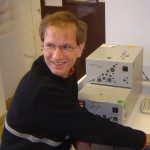Link to Pubmed [PMID] – 12051849
J. Mol. Biol. 2002 Apr;318(2):429-42
The possibility of obtaining from any antibody a fluorescent conjugate which responds to the binding of the antigen by a variation of its fluorescence, would be of great interest in the analytical sciences and for the construction of protein chips. This possibility was explored with antibody mAbD1.3 directed against hen egg white lysozyme. Rules of design were developed to identify the residues of the antibody to which a fluorophore could be chemically coupled, after changing them to cysteine by mutagenesis. These rules were based on: the target residue belonging to a topological neighbourhood of the antigen in the structure of the complex between antibody and antigen; its absence of functional importance for the interaction with the antigen; and its solvent accessibility in the structure of the free antibody. Seventeen conjugates between the single-chain variable fragment scFv of mAbD1.3 and an environment-sensitive fluorophore were constructed. For six of the ten residues which fully satisfied the design rules, the relative variation of the fluorescence intensity between the free and bound states of the conjugate was comprised between 12 and 75% (in non-optimal buffer), and the affinity of the conjugate for lysozyme remained unchanged relative to the parental scFv. In contrast, such results were true for only one of the seven residues which failed to satisfy one of the rules and were used as controls. One of the conjugates was studied in more detail. Its fluorescence increased proportionally to the concentration of lysozyme in a nanomolar range, up to 90% in a defined buffer, and 40% in serum. This increase was specific for hen egg lysozyme and it was not observed with a closely related protein, turkey egg lysozyme. The residues which gave operational conjugates (six in V(L) and one in V(H)), were located in the immediate vicinity of residues which are functionally important, along the sequence of FvD1.3. The results suggest rules of design for constructing antigen-sensitive fluorescent conjugates from any antibody, in the absence of structural data.

